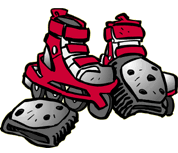INLINE SKATING ACTIVITY CARD
Parts of the Body Worked

Upper & Lower Legs

Heart & Lungs

Hips & Butt

Lower Back

Just what does it take to do inline skating?
Gear Up
There are several different types of inline skates, depending on the type of skating you do. Recreational skates have a plastic boot and 4 wheels. These skates are best for beginners. Hockey skates have laces and are made of leather with small wheels for quick movement. Racing skates have 5 wheels and, usually, no brake. Freestyle skates have three wheels and a pick stop for tricks. Fitness skates have larger wheels and are used for cross-training. Aggressive skates, the kind worn by X Games competitors, are made of thick plastic with small wheels for quick movement, and grind plates to protect the skate when doing tricks. No matter what kind of skates you wear, always wear a helmet, as well as wrist guards, elbow pads, and knee pads.
Play it Safe
Avoid getting hurt by making sure your helmet and pads are on correctly. Your helmet should be tightly buckled, with the front coming down to right over your eyebrow, and your pads should be on tight, so they don’t slip while you are skating. It’s also important that your helmet is approved by one of the groups who test helmets to see which ones are the best: the Consumer Product Safety Commission (CPSC), or Snell B-95 standards are best for inline skating helmets. Make sure you are always in control of your speed, turns and stops, and be careful of cracks in the pavement where you are skating — they can be dangerous if your wheels get caught in them. It’s best to go skating out of the way of traffic and other people (skating rinks are great places to skate).
How to Play
If you’re just beginning inline skating, here are some tips to get you rolling.
Practice balancing on your skates by walking in them on a flat, grassy area. As you move to the pavement, balance yourself without trying to move. Gradually begin to skate by moving forward, but not too fast. Keep your knees bent and flexible when you skate — it will keep you more stable. And if you fall — fall forward. Then you will fall on your kneepads — they’re there to protect you!
It’s also a good idea to take lessons from a certified instructor — you can find one through the International Inline Skating Association. As you get more skilled on your skates, there are several types of competitive inline skating activities — like speed skating and aggressive skating, which includes events like those at the X Games. There are also sports leagues just for those who play on wheels, such as roller hockey, roller soccer, and roller basketball.
Games
Skate on one foot. Practice balancing on one foot at a time while you’re skating. See how long you can glide on each foot. This is a great way to work on your balance!
Skate with friends. Go inline skating at the local park or skating rink, or join a skate club in your town.
Combine activities. Tired of just skating around in circles? Grab some friends for a game of inline hockey, inline basketball, or even inline soccer.
Fun Facts
Inline skates were invented by a Minnesota hockey player so that he could skate during the off-season.
California has the most inline skaters — 3.6 million residents of the Golden State regularly go inline skating.
Many professional skiers use inline skating to train during the off-season, because some of the skills of each activity are the same.
Related Links
- Page last reviewed: May 9, 2015
- Page last updated: May 9, 2015
- Content source:



 ShareCompartir
ShareCompartir